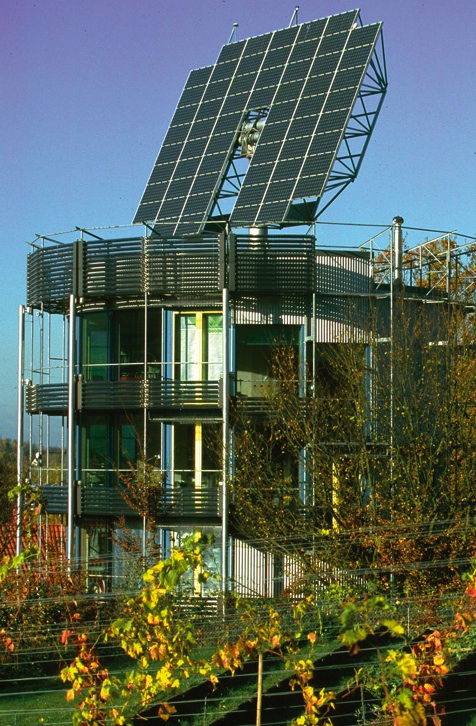
Image Credit: Rolf Disch Solar Architecture
Heliotrope, a solar-powered house in Frieberg, Germany, with just under 2,000 sq. ft. of interior space, is hard to pass up as a blog item. Inhabitat and TechCrunch’s GreenTech both devoted space to it in part because of its unusual appearance, the robust output of its rotatable solar array (with 6.6 kW capacity), and the way the building embodies architect Rolf Disch’s PlusEnergy principle of construction, in which each home produces more energy than it uses.
The house, in fact, is designed to produce five times more energy than it uses through a combination of passive solar gain and a dual-axis tracking system designed to allow the home’s 54-square-meter “sun sail” array to maximize power output. In a summary of Heliotrope features, Disch says the tracking system increases the sun sail’s energy gain by 30% to 40% over what would be expected from a fixed system of similar size.
In constant motion
The array actually isn’t the only thing that moves to accommodate solar exposure. Because the 18-sided cylindrical exterior consists mostly of triple-glazed windows, the entire house is designed to rotate so that the fully exposed windows on the “front” of the house are positioned for maximum solar gain during the winter, while during the summer the “backside” of the cylinder, which is equipped with balconies that also serve as fire escapes and sun shades, is rotated toward the sun to minimize solar gain. Disch says that under normal conditions the building rotates about 15 degrees an hour to follow the sun.
Weekly Newsletter
Get building science and energy efficiency advice, plus special offers, in your inbox.
The architect, who lives in the prototype, notes that while Heliotrope is by no means the only building to rotate around a central column, it likely is unique in its attempt to use rotation to so closely align the advantages of passive solar and solar power. But beyond the complexities of its mechanical systems and concerns that might be raised in many communities over the building’s unusual appearance, Heliotrope is impractical on anything but a relatively large lot. Too, it is not for clients who don’t have the money for construction costs, which have come in at almost $1.5 million for each of the three Heliotropes built so far.















0 Comments
Log in or create an account to post a comment.
Sign up Log in